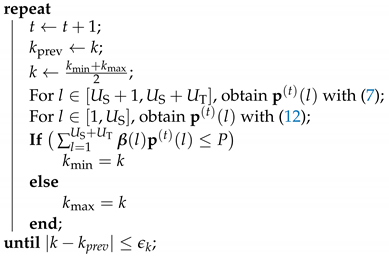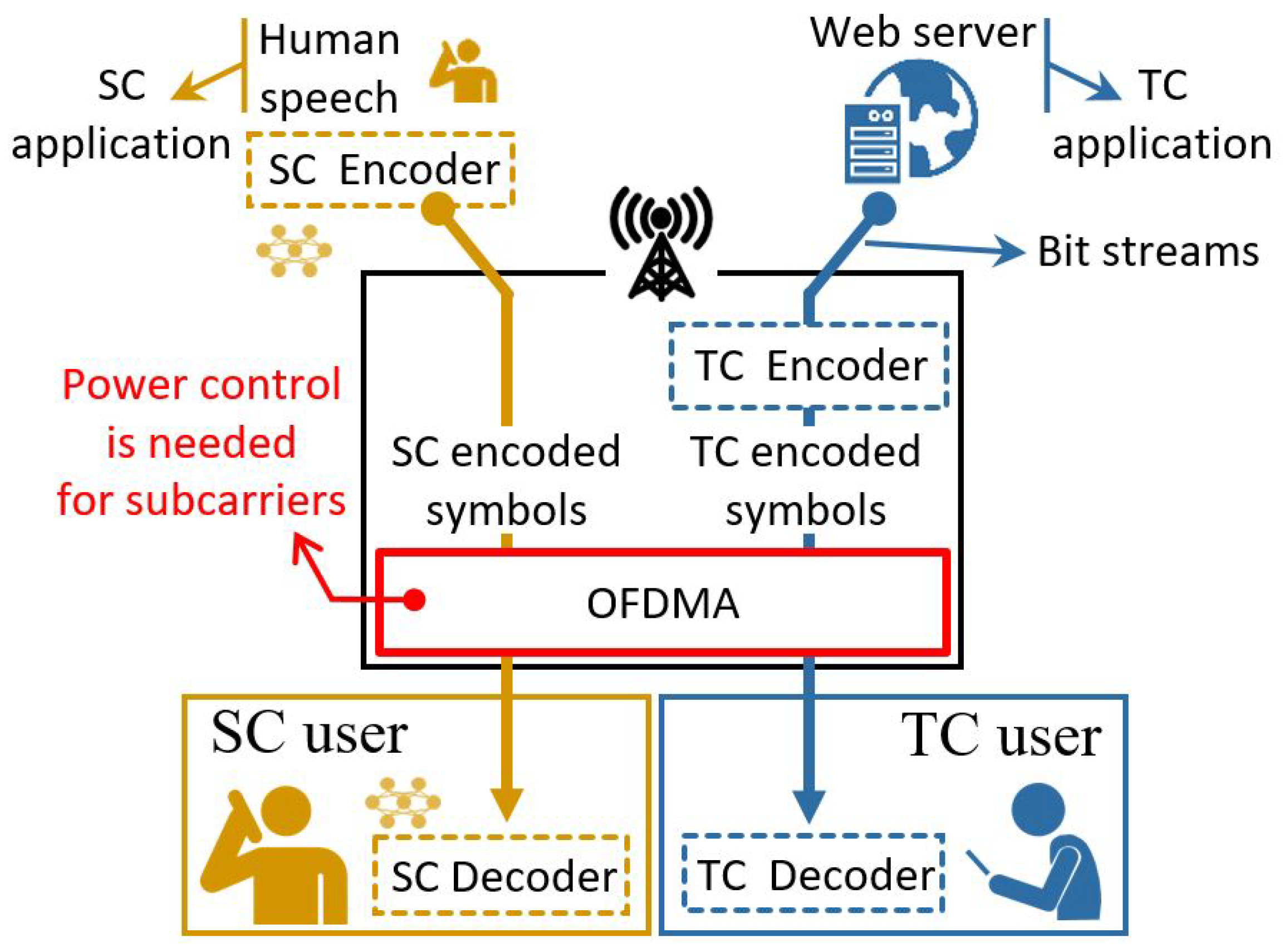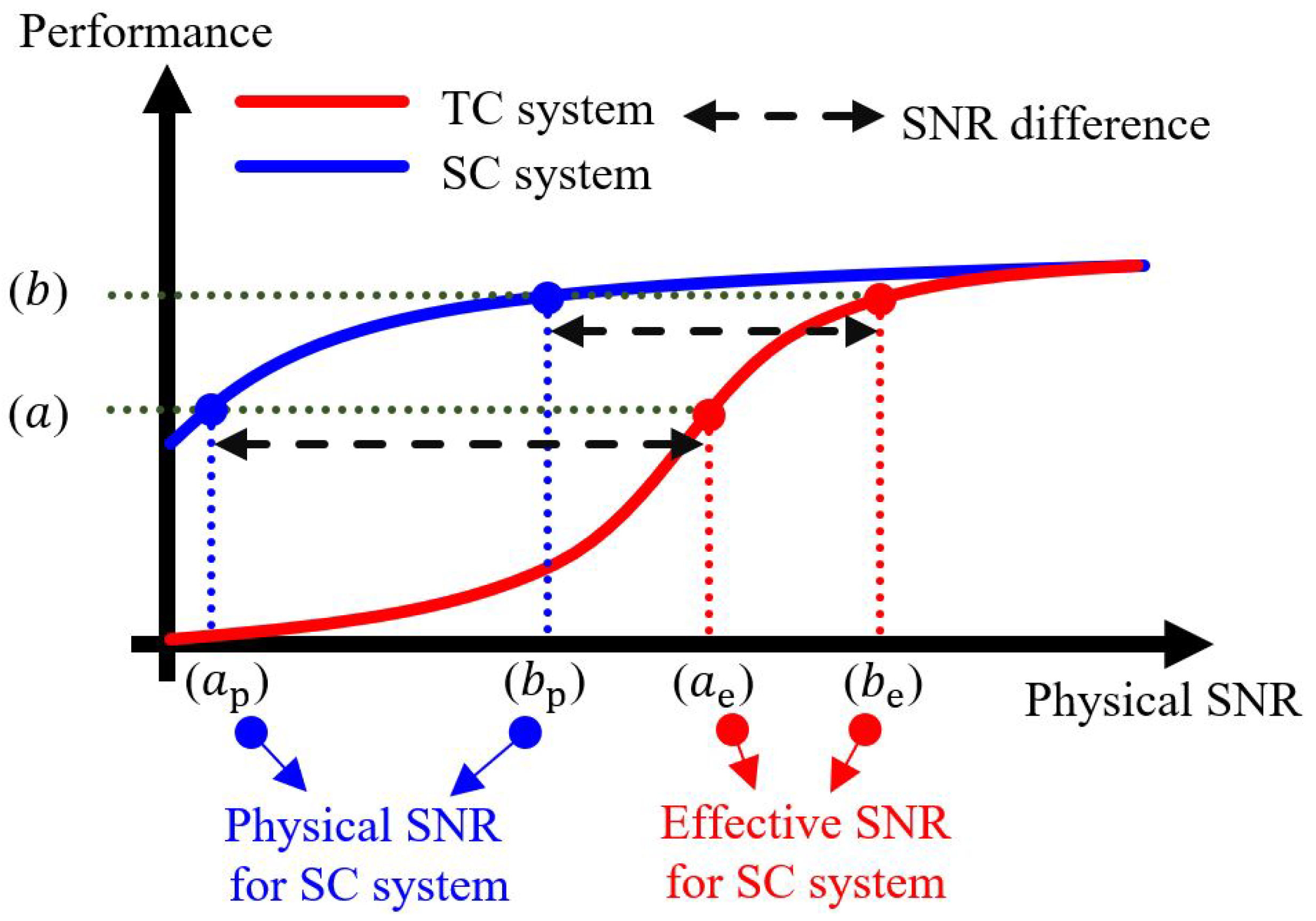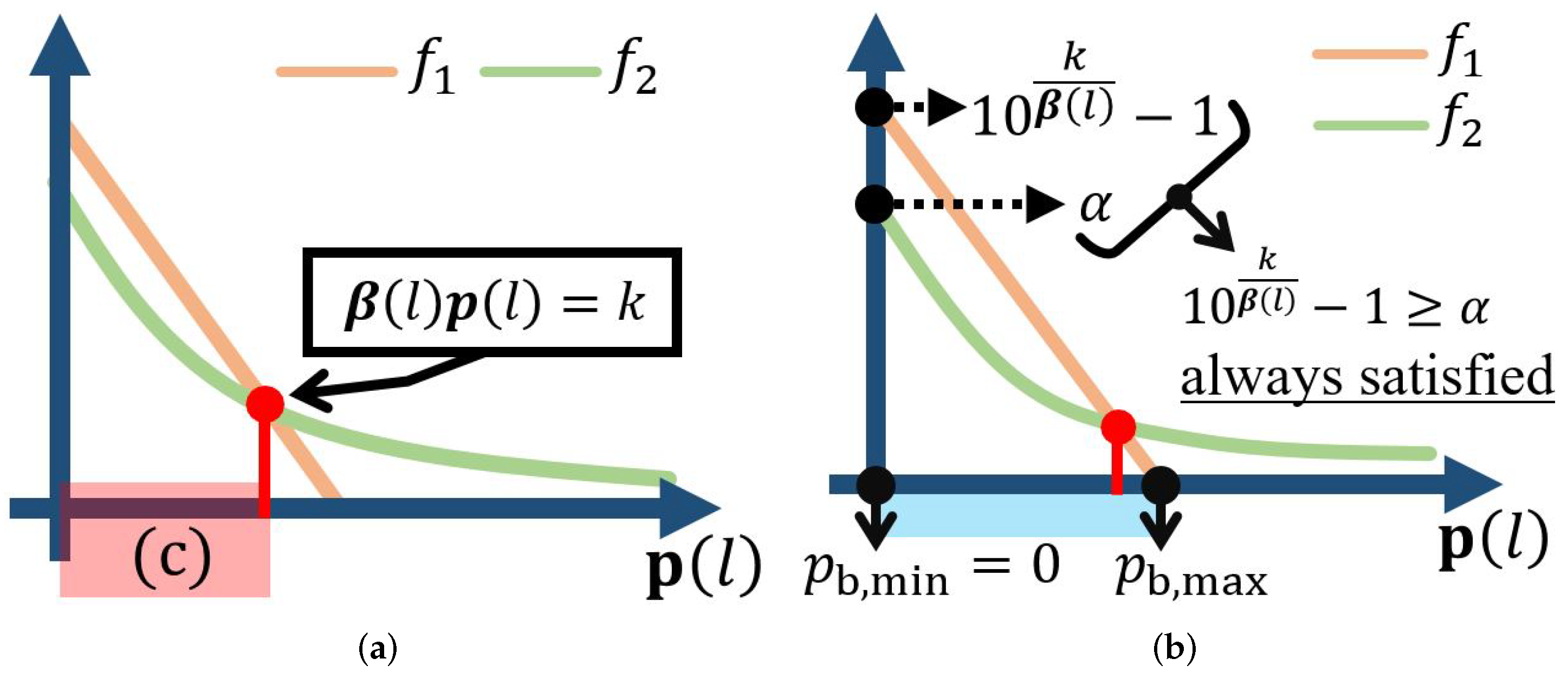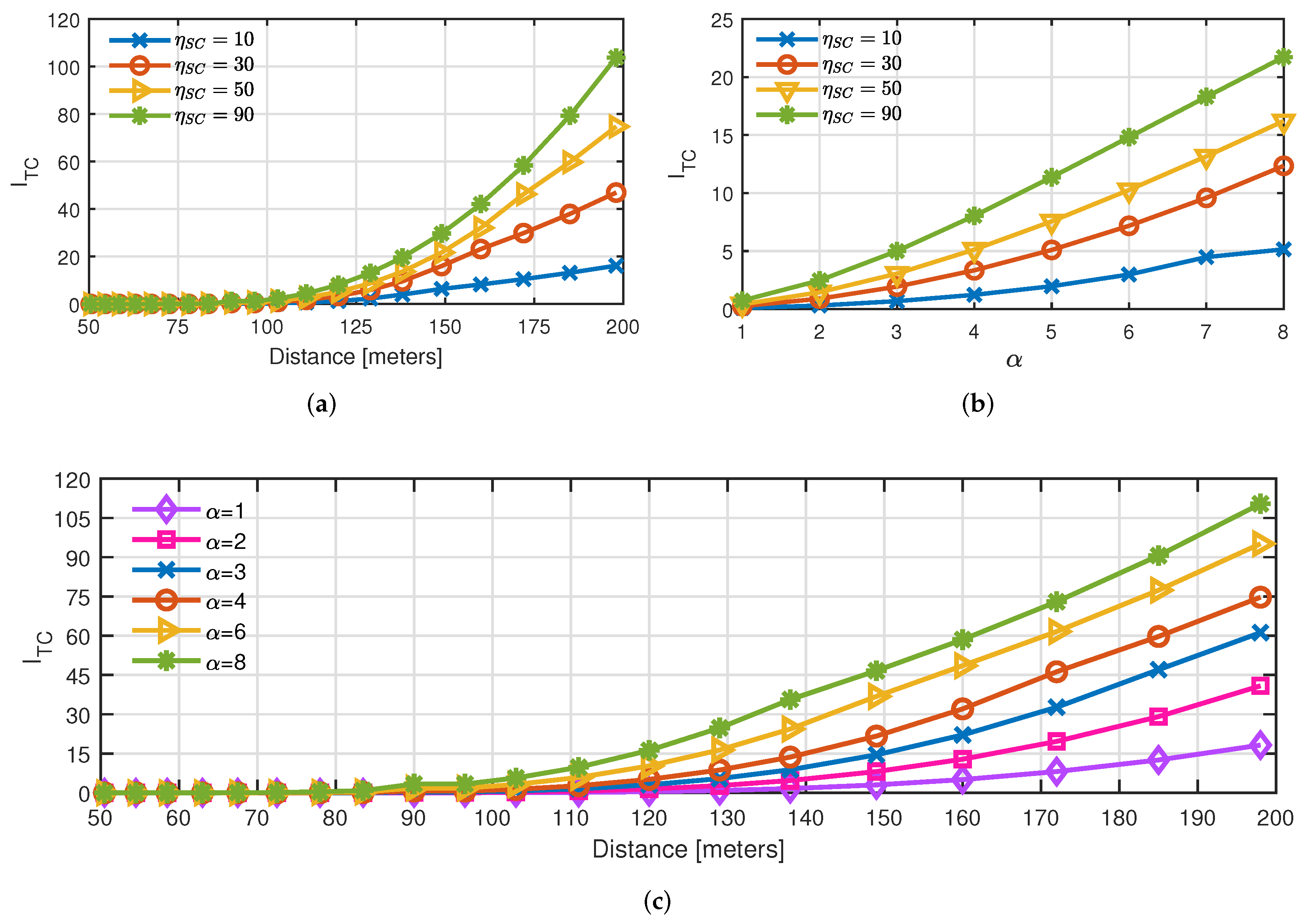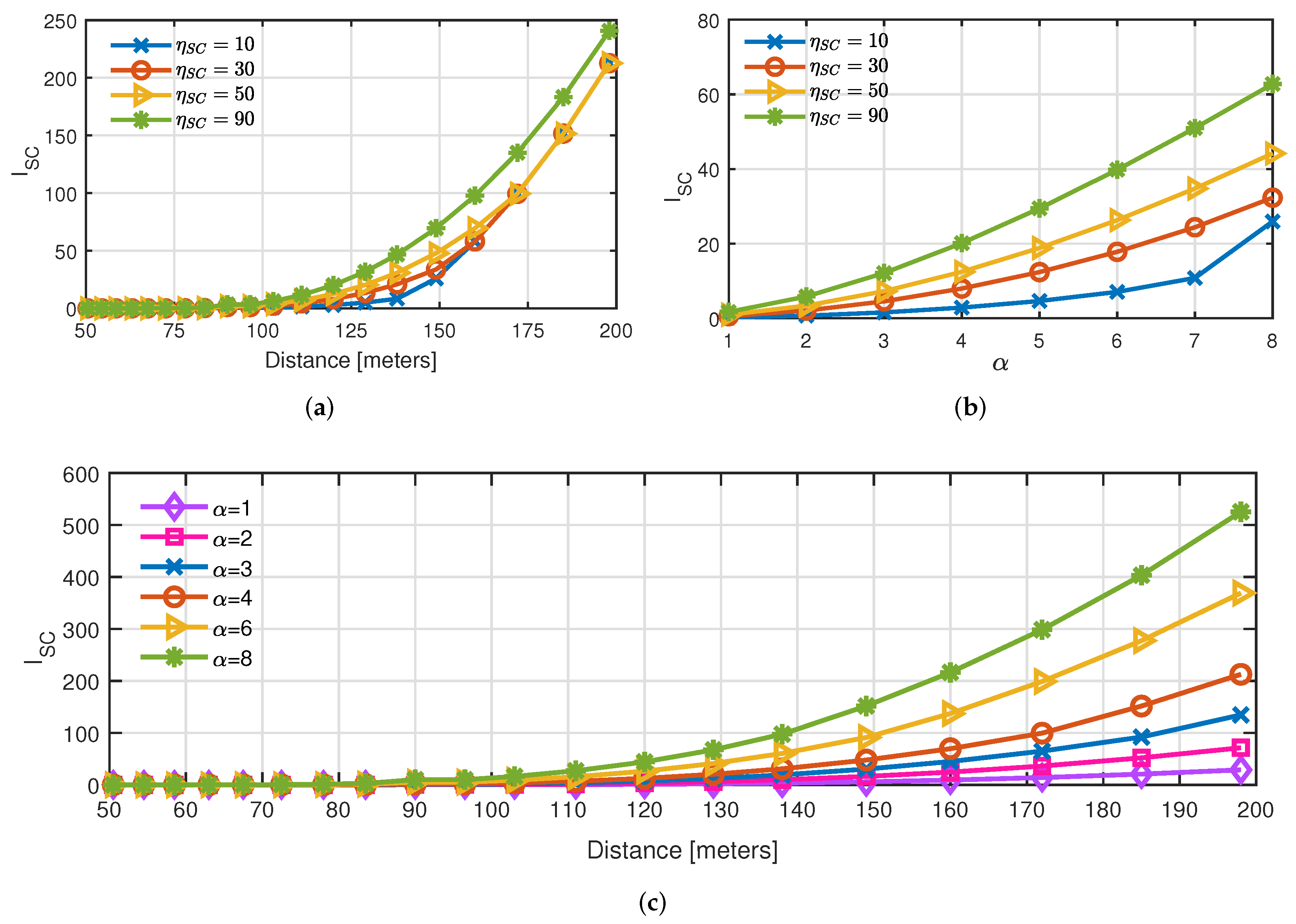1. Introduction
In order to address the conflicting challenge of the ever-increasing demand for mobile traffic and the scarcity of frequency resources, semantic communication (SC) is emerging as a new paradigm of next generation communication, which is expected to move beyond Shannon [
1,
2,
3,
4]. Recently, the fifth generation (5G) of wireless communication systems has been successfully deployed to enhance the communication capacity, and the research on the sixth generation (6G) has also started for future networks. However, the approaches of 5G and 6G are still not completely free from the problem of resource scarcity. Although this problem can be alleviated by using additional high-frequency bands such as THz, the inherent problems of high-frequency signals inevitably lead to some additional issues such as blocking, power amplifier efficiency drop, and atmospheric absorption [
5].
Unlike the approaches of conventional communication systems, the new paradigm of the semantic communication pursues the meaning behind bits and the brain-like cognition. In this paradigm shift, the main goal is to successfully convey the meaning of transmitted messages to a receiver rather than symbol-level error-free communication. To better understand the transfer of meaning, we discuss human communication. As we all have experienced, people can communicate well even in noisy environments. The reason of such well communication is because people share the background knowledge and experience about communication in noise environments. With the help of shared knowledge, people can obtain meaningful information even in voices that are slightly distorted by noise. In addition to the background knowledge, the success is possible because the voice signals still contain usable meaning. Therefore, for the new semantic communication, a transmitter and a receiver should be able to encode exploitable meaning, and share the background knowledge for a given task.
In order to realize the new paradigm of communication, some researchers have utilized deep learning that recently achieves remarkable progress in the field of computer vision. During the training, deep-learning based encoder and decoder networks naturally share the same background knowledge needed for given tasks. Therefore, by implementing an encoder network and a decoder network in a transmitter and a receiver, several SC systems have been developed for several fields: language transmission [
6,
7,
8,
9], speech transmission [
10], and image transmission for recognition [
11,
12,
13]. Especially, recent research presents a notable common result that SC systems using deep networks achieve improved performance in low SNR regime compared to traditional communication (TC) systems (a TC system refers to a communication system that utilizes traditional source coding and channel coding approaches such as Turbo coding).
Since the training optimizes deep neural networks to work well for the specific tasks, the existing SC systems also specialize in the communication of applications that handle tasks using deep networks. However, due to the task-specific development approach, SC systems cannot be used for users not using applications that can adopt the SC systems. In this case, a TC system still should be used to provide applications that are not capable of deep learning. Therefore, SC and TC systems inevitably coexist, and thus a base station (BS) should provide services to SC and TC users simultaneously. Unlike traditional network scenarios consisting of only the same TC system, the coexistence can change the network performance of TC users.
Although recent works have successfully realized semantic communication that was a conceptual idea and presented performance improvement compared to TC systems, it is still questionable how SC systems affect TC systems in a scenario where TC and SC systems coexist. In order to convince that implementing SC systems is indeed a promising solution as a next-generation communication, it is necessary to show that SC systems can coexist well with TC systems in terms of network performance, such as sum-rate improvement and SNR improvement. In other words, it is necessary to show that an SC system can be implemented without compromising the performance of a TC system. SC and TC systems Specifically, we investigate the change in the performance of TC users as some users begin to be served by SC systems. According to the common result of existing SC systems, the signal-to-noise ratio (SNR) of users served by SC systems is modeled differently from that of TC users. With the consideration of the SNR of SC and TC users, a max-min fairness problem for power control is formulated and analyzed. Extensive numerical simulations present that with the introduction of SC systems, users served by an SC system can experience better performance than when receiving services through the TC system. Moreover, a BS can allocate more transmit power to a TC system by exploiting the performance improvement by SC systems in low SNR regimes. In addition to improving the performance of users serviced by an SC system, the change in transmit power allocation also improves the sum-rate of users serviced by the TC system. As a result, this work confirms that such an SC system is a promising next-generation communication that can improve network performance without acquiring additional frequency resources.
The contributions of this work are summarized as follows:
In this paper, we first introduce the possibility of the coexistence of SC systems and TC systems that can occur with the advent of SC systems. However, existing works only focus on the realization of semantic communication without the consideration of the coexistence of SC systems and TC systems. Therefore, we investigate the impact of the introduction of SC systems on the performance of TC systems. Specifically, we analyze the coexistence of them in terms of fairness, and thus formulate a max-min fairness problem of the performance of SC systems and TC systems;
To formulate the coexistence problem, we introduce the signal-to-noise ratio (SNR) of an SC user by reflecting the performance difference between SC and TC systems. The modeled SNR of SC users allows modeling the coexistence of systems with different SNR characteristics;
Via numerical results, we show that the introduction of SC systems leads to an increase in the sum-rate of a TC system, and the improvement can be up to . For SC systems, it is important to ensure that SC systems can be utilized without compromising the performance of the surrounding TC system. Then, in this work, it is confirmed that such an SC system is indeed a promising next-generation communication that can improve network performance without securing additional frequency resources. We show that SC systems can coexist fairly with TC systems.
Note that the development of SC systems can be more meaningful when there is a guarantee that the SC system should be usable without degrading the performance of the TC system. This work shows the performance improvement of TC systems according to the introduction of SC systems, and thus can guarantee the significance of the SC systems.
The rest of the paper is organized as follows. The coexistence model is explained in
Section 3. In
Section 4, we analyze the SNR of a user served by an SC system and a user served by a TC system. By using the SNR of each system, we formulate a max-min fairness problem in the coexistence of an SC system and a TC system in
Section 5. In order to show the effect of introducing an SC system, the numerical results are presented in
Section 6. Finally,
Section 8 concludes the paper.
2. Related Works
As deep learning has made outstanding achievements in the field of computer vision, it is confirmed that deep learning can be a promising solution to deal with difficult yet unresolved problems. The literature [
14,
15] argued that deep learning specializes in extracting complex but meaningful features that cannot be recognized and analyzed using conventional schemes. The advantage of deep learning has taken technologies of natural language processing [
16] and audio signal processing [
17] to the next level as well as computer vision [
18].
To improve the performance of existing wireless technologies, several researchers have tried to apply deep-learning networks to physical (PHY) layer [
19], channel estimation [
20], modulation classification [
21,
22], resource allocation [
23], beamforming [
24], power control [
25], and spectrum sensing [
26,
27,
28,
29,
30,
31]. The work [
19] designed a communication system as an end-to-end reconstruction task that jointly optimizes the components of a transmitter and receiver. In [
21,
22], the authors improved the performance of modulation classification in MIMO through deep learning by canceling multi-user interference. In [
20], they proposed a deep learning framework to improve channel estimation and DOA estimation. The works [
23,
25] utilized deep learning to improve existing resource management technologies such as frequency resource allocation and power allocation, and the authors of [
24] proposed a deep learning framework that designs beamforming vectors for a MISO system. For spectrum sensing, the works [
26,
27,
28,
29,
30] proposed supervised learning-based schemes to decide whether a channel is occupied by a primary user, while the authors of [
31] developed an unsupervised deep learning based spectrum sensing method.
Although the existing works have introduced deep learning to the field of wireless communication, they have focused on enhancing existing wireless technologies. On the other hand, semantic communication has been proposed to open the new paradigm of communication. Astonishing progress in deep learning can make semantic communication feasible in some fields of language transmission [
6,
7,
8,
9], image transmission for recognition [
11,
12,
13], and speech transmission [
10]. In [
9], the authors proposed a deep-learning based joint source-channel coding framework that aims to recover the meaning of a source at a receiver. That is, even if there are some errors in the received symbols, the proposed framework can successfully decode the original meaning of the transmitted symbols. Using deep neural networks, the works [
6,
7,
8] developed SC systems that extract and send the semantic information of text data. To realize such SC systems, they constructed encoders using a transformer network that achieves great performance in natural language processing. In [
11,
12,
13], some deep learning based encoders and decoders were proposed to extract meaningful semantic information from images. The work [
13] proposed a joint transmission–recognition framework that efficiently sends image data to a server for recognition task. For an SC system of speech transmission, in [
10], they adopted an SE-ResNet module that specializes in detecting meaningful information among meaningless information in feature maps.
Moreover, deep learning has been adopted to applied science such as the field of UAV/drone detection schemes [
32,
33]. The authors of [
32] combined a deep learning network and millimeter wave (mmWave) to classify the types of drones. In [
33], they utilized deep learning to detect malicious drones among valid drones.
4. Signal-to-Noise Ratio of an SC User
According to [
6,
8,
10,
11,
12,
13], for the same SNR value within a low SNR regime, an SC system can provide a higher performance to SC users compared to a TC system. In other words, if both the SC system and the TC system start transmission with the same transmit power, the SC system can provide a higher performance to SC users compared to the TC system. Therefore, in order to examine the effect of introducing an SC system, it is necessary to reflect the performance difference between SC and TC systems according to the SNR value. In this work, the performance difference between both systems is considered by modeling the SNR of SC users served by an SC system and the SNR of SC users served by a TC system differently.
For a TC system, the SNR of users is defined by dividing the strength of a received signal by noise, which is referred to as physical SNR. Therefore, the SNR of TC user
j and SC user
i served by a TC system is represented, respectively, as:
where
is the noise PSD level.
For the same transmit power, an SC system can provide a better performance than a TC system. In general, performance improves with increasing SNR. Hence, the symbol transmitted through an SC system can be considered to be received effectively at a higher SNR than that transmitted through a TC system, which in this work is referred to as an effective SNR for the SC system. According to [
6,
8,
10,
11,
12,
13], for an SC system, the difference between effective SNR and physical SNR increases as physical SNR decreases. On the other hand, the SNR gain obtained by an SC system becomes smaller and zero as the physical SNR increases. For a TC system, effective SNR is naturally the same as physical SNR.
For problem formulation, the SNR of an SC user served by an SC system is defined by the effective SNR. The effective SNR is modeled by reflecting the correspondence between the performance of an SC system and the performance of a TC system. For better understanding, we discuss
Figure 2, which shows an example of the performance of an SC system and a TC system with varying physical SNR, drawn based on the results of existing SC system studies [
6,
8,
10,
11,
12,
13]. In order to achieve the same performance (a), an SC system and a TC system require the physical SNR indicated by (
) and (
), respectively. From the perspective of the TC system, the physical SNR of the SC system is effectively
, and thus the effective SNR for the SC system is
. The difference between effective SNR and physical SNR decreases exponentially as the physical SNR increases. Since the effective SNR is the sum of physical SNR and exponentially decreasing difference, we model the SNR of SC user
i served by an SC system by adding an exponential function and a linear function as:
where
and
are SC system parameters, and
is a noise PSD level. The SC system parameter
corresponds to the degree of performance improvement by an SC system. The higher the
value, the greater the performance improvement by an SC system in a low SNR region. Another SC system parameter
is necessary for
to be a monotonically increasing function because SNR physically should continue to increase with increasing transmit power. Hence,
should be satisfied with
.
Equation (
2) consists of physical SNR and gain of an SC system. The gain exponentially decreases as transmit power increases, which well reflects the characteristic of performance improvement within a low SNR regime of an SC system. Note that (
2) can be considered as a generalized form of the SNR of SC users served by SC systems, since it can represent various SC systems by varying
and
. Although (
2) might not accurately model the performance difference between a TC system and SC systems for the previous studies, it still reflects the tendency of the performance difference between an SC system and a TC system. Moreover, the performance difference between an SC system and a TC system is not the same for all the previous studies. Therefore, with (
2), we can sufficiently analyze the impact of the introduction of an SC system from a general point of view.
Finally, depending on the system providing an SC service to SC user
i, the SNR of SC user
i is expressed differently as:
5. Impact Analysis of Introducing an SC System
In order to examine the effect of an SC system, we consider a max-min fairness problem in the coexistence of an SC system and a TC system. For problem formulation, the spectral efficiency for SC user
i and TC user
j is used, which is represented as
and
, respectively. (By using the same spectral efficiency as a performance metric for both the SC system and the TC system, this work focuses on how the coexistence of systems with different SNR equations affects the performance of users). This paper considers the optimal way to fairly allocate transmit power to two different systems from a performance fairness point of view. Therefore, a max-min fairness problem for power control is written as:
where the spectral efficiency vector is denoted as
, the
l-th element of which is
. The objective (
4a) ensures that all SC and TC users can be guaranteed the same spectral efficiency. The conditions (
4b) and (
4c) are the maximum power constraint and the maximum resource constraint. The constraint
is the nonnegative power condition.
For given
k, (
4a–
4c) is solved when
is satisfied. Then, by maximizing
k, the optimal
is obtained. To find the optimal
k, a bisection method will be used, and thus we need to find the minimum initial
k and the maximum initial
k, denoted as
and
, respectively.
5.1. Maximum and Minimum Initial Values to Solve the Max-Min Fairness Problem
In order to obtain
and
, we need to consider a set
including all feasible values of
k. The set
is determined by a set that includes all feasible vectors
for the vector space of
, where the operator ∘ is element-wise multiplication. The values of
and
are the minimum and maximum elements in
, respectively. Then, the variable
can be obtained as follows:
For (
5), the minimum of
can be obtained with
. Then, with
, the solution of
is calculated as:
Hence,
. Furthermore, the variable
can be calculated as:
For (
6), the maximum of (
) can be calculated with
. Note that
is the largest value that can be allocated to an SC system or a TC system. Therefore, with
, the solution of (
) can be obtained as:
5.2. Solution for , with Given k
For TC user
l and
, we have
, and thus the explicit analytic solution
is as:
For
, if SC users are served by an TC system, the optimal solution
with a given
k is obtained using the same equation as (
7), which is as:
If SC users are served by an SC system,
can be written as:
Although an explicit analytical solution cannot be derived, we can obtain the solution for (
9) by selecting the largest value of
that satisfies
or the smallest value of
that satisfies
.
In
Figure 3a, the red point at the intersection of
and
satisfies (
9), and can be obtained by taking the maximum value within the red box (c) that satisfies
. Hence, mathematically, it can be written as:
In order to find
, the bisection method can be performed on (
10). For the bisection method, we need to obtain the minimum and maximum initial values,
and
. As in
Figure 3b,
is the point for
, and thus can be obtained as:
Since
for
, in
Figure 3b, the intersection of
and the
y-axis is always larger than that of
and the
y-axis. That is, there is always a single intersection of
and
, and thus we simply set
to zero.
For
, the transmit power for SC user
l is obtained as:
5.3. Overall Algorithm
Finally, can be obtained iteratively, which is summarized in Algorithm 1. In this work, the same frequency bandwidth is allocated to all users, .
| Algorithm 1: Power Control Algorithm. |
Result: Initialize , , a small , , and any feasible ; |
5.4. Complexity Analysis
In Algorithm 1, the parameters
,
,
,
, and
are closed form solutions. The bisection methods for
k and
contribute to the complexity of the power control algorithm. The complexity is as:
where
and
are the tolerances of
and
k, respectively. Therefore, we can control the process of Algorithm 1 using
and
. Both parameters are empirically determined as
and
, respectively. With
and
, the parameters
k and
are usually determined near
and
, and thus the settings are appropriate. Furthermore, the number of iterations required to complete Algorithm 1 is less than 1800 with probability 0.99. Since the bisection methods include simple arithmetic operations, the completion time is less than 2.6 msec with Intel(R) Core(TM) i7-9700.
6. Numerical Results
With a total of 10 users, the simulations are performed with
,
,
, and
dBm [
36]. To focus on performance changes due to the introduction of an SC system, all users are placed at the same distance from a BS, where the distance from a BS is
meters.
In this evaluation, we present changes in allocated transmit powers, rates of TC users, and the SNR of SC users, as the system providing services to SC users is changed from the TC system to the SC system. In the resulting figures,
is the ratio of the number of SC users to the total number of users, and thus is obtained as
. In addition,
and
are the sum-rate improvement of TC users and the average SNR improvement for each SC user, both of which are calculated as:
where
and
are the sum-rate of TC users when SC users are served by an SC system and when SC users are served by a TC system, respectively. The parameters
and
are the SNR of SC user
i when SC user
i is served by an SC system and when SC user
i is served by a TC system, respectively. The reason for showing the improvement in the SNR of SC users is that the performance metrics of existing SC systems depend on SNR according to [
6,
8,
10,
11,
12,
13] since these increase with increasing SNR.
For
meters,
, and
,
Figure 4 shows the allocated transmit power, the SNR values of SC users, and the rates of TC users. These results present how those values change with varying the distance
D between a BS and users, the performance degree
of an SC system, and the number of SC users served by an SC system.
In the figures, the green bars are the results of the scenario with only the TC system. In
Figure 4a,c,e,g, the yellow bars inside the red dotted rectangle and the blue dotted rectangle mean the allocated transmit power of SC users and TC users, respectively, when SC users are served by an SC system. In addition, in
Figure 4b,d,f,h, the yellow bars inside the red dotted rectangle and the blue dotted rectangle indicate the SNR values of SC users served by an SC system and the rates of TC users, respectively.
As in
Figure 4a,c,e,g, by changing from the TC system to the SC system for SC users, additional power can be allocated to TC users while the power allocated to SC users is reduced. This is because at a low SNR, an SC system can serve SC users with the performance that the TC system can achieve at high SNR. In
Figure 4b,d,f,h, the change in power allocation improves the rates of TC users, and the SC system has the effect of increasing the SNR of SC users even with lower transmit power.
In
Figure 4a,c, as the number of SC users served by an SC system increases, the reduction in the allocated transmit power decreases. Then, all the reduced transmit power of SC users is allocated to the TC system. Hence, the performance of both SC users and TC users can be improved by increasing the number of SC users served by an SC system.
Figure 4b,d shows that the SNR improvement of an SC user and the rate improvement of a TC user increase by 8.6 % and 5.6 %, respectively.
Figure 4a,e shows that, as the distance
D decreases, the reduction in transmit power of the SC users decreases and therefore the increase in the transmit power of TC users also decreases. In the same vein, as in
Figure 4b,f, the SNR improvement and the rate improvement also decrease. In other words, as the distance
D increases, the performance gain due to the introduction of an SC system increases.
Finally, as in
Figure 4e,g, as the performance degree
increases, the allocated transmit power to SC users decreases, and thus those to a TC system increases. That is, the higher the value of
, the greater the SNR improvement and the rate improvement as in
Figure 4f,h.
To examine the overall effect of an SC system,
Figure 5 and
Figure 6 present the sum-rate improvement of TC users and the average SNR improvement of SC users with varying
D,
, and
.
Figure 5a and
Figure 6a show that with fixed
,
and
increase as the distance and
increase. For fixed
meters,
Figure 5b and
Figure 6b show that as both
and
increase,
and
also increase. Finally, for
,
Figure 5c and
Figure 6c confirm that the increase in
D and
leads to the increase of
and
.
Note that the increase in D means that users physically experience a lower SNR. That is, if TC and SC users suffer from bad channels, using an SC system for SC users can improve the performance of both TC users and SC users. As the number of users served by an SC system increases, both sum-rate improvement and SNR improvement increase. Furthermore, the results confirm that the use of existing spectral efficiency for an SC system can effectively lead to performance improvement for both SC and TC systems.
7. Discussion
Overhead of SC systems: In this section, we discuss the overhead of using SC systems. The overhead comes from the difference between an SC system and a TC system. The main difference between them is how symbols for communication between a transmitter and a receiver are generated from data. In semantic communication, the communication symbols are created using deep neural networks. That is, the processing time of the neural networks used is a dominant overhead in semantic communication and varies depending on applications. For investigating the overhead, we analyzed the public code of a recent work [
6], which utilizes the popular transformer in natural language processing. The processing time of data with a batch size of 128 is only 52 milliseconds with AMD Ryzen9 5950X 16-Core processor. Like in the work [
8], researchers in SC systems also consider developing lightweight deep learning-based encoders and decoders. Furthermore, the work [
12] considered the wireless edge scenario and thus developed a lightweight deep learning framework. As a result, the overhead due to the processing time of neural networks can be expected to be negligible.
Privacy and security of data: Since existing works focusing on the development of SC systems did not consider the privacy and security of data, how to handle the data privacy and security could be a new research work in semantic communication. In response to data privacy issues, organizations such as the European Union have passed restrictive laws and regulations such as the General Data Protection Regulations (GDPR) [
37]. Therefore, the development of a data privacy management model for semantic communication could be one of the important new studies [
38].
Architecture for coexistence of SC and TC systems: Although we focus on the analysis of a coexistence of SC and TC systems in this work, we additionally discuss an architecture for the coexistence. In general, a mapping function layer is needed to integrate different systems [
39]. However, the difference between the SC system and the TC system is how to create OFDM symbols from data. As shown in
Figure 1, in the case of a TC system, an encoder generates OFDM symbols directly from a bit stream of data. In an SC system, OFDM symbols are generated using a deep learning-based encoder that extracts the meaning of data from a bit stream. Once OFDM symbols are created, the symbols can be simply transmitted via OFDMA. At this point, an architecture for distinguishing the bit stream of the TC system from the SC-encoded symbols is required, because the bit stream of the TC system is encoded into OFDM symbols in a BS. Such architecture for a BS could be developed using technologies such as network virtualization. Since our analysis results provide that the coexistence of SC and TC systems increases the network performance, the development of an architecture would be one of the important works in semantic communication.
8. Conclusions and Future Works
In this paper, we investigated how SC systems actually affect network performance. By considering the tendency of performance improvement by SC systems, we model the SNR of SC users served by an SC system and then formulate a max-min fairness problem. The numerical results show that changing from a TC system to an SC system for SC users increases the sum-rate performance of TC users by allocating more power to TC users, while also improving the SNR of SC users. If users suffer from low SNR and the number of SC users served by SC systems increases, an SC system can achieve a significant performance improvement. This work is meaningful in that it shows how the network performance changes when two systems with different SNR tendencies for the same transmit power coexist. It confirms that the SC system is indeed a promising next-generation alternative and improves network performance without securing additional frequency resources. Furthermore, this work guarantees that the development of SC systems is really meaningful, and then is expected to facilitate future research on the utilization of SC systems in various applications.
Finally, we believe that this paper will lead to some research on multiple input multiple output (MIMO), user management, and load balancing in the coexistence of TC and SC systems. Based on the coexistence analysis of this work, in the future, further from the coexistence analysis, we would like to develop a framework that jointly designs an SC system and a TC system to maximize the benefit of SC systems, consistent with integrated access and backhaul, another new paradigm of wireless communication [
40,
41]. To comprehensively evaluate the future work, we will utilize various metrics such as system performance and overheads. Additionally, semantic communication can be used for efficient data transmission. Therefore, in addition to such conventional research fields, we will study how to apply semantic communication to mobile device-based applications that require efficient transmission [
42,
43,
44,
45].
